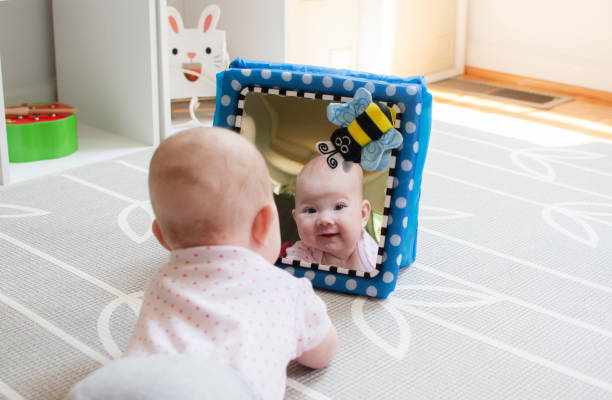Tummy time is one of those things every new parent hears about — and then quietly worries about.
Is my baby getting enough? Are they too small? What if they hate it?
Take a deep breath. Tummy time doesn’t have to be stressful.
It’s simply giving your baby a chance to explore the world from a new angle, building the muscles they’ll soon use to roll, crawl, and sit.
Here’s a calm, month-by-month guide to tummy time, so you can feel confident and enjoy these little milestones together.
Why is Tummy Time Important?
Tummy time is more than just a way to keep your baby busy. It helps your little one:
- Build strong neck, shoulder, and arm muscles — important for rolling over, sitting up, crawling, and eventually walking.
- Develop motor skills and body awareness.
- Prevent flat spots on the back of the head (positional plagiocephaly), which can happen if babies lie on their backs too much.
A little tummy time every day adds up to big benefits down the road.
When to Start Tummy Time?
The best time to start tummy time is from the very first days home.
Right after birth, your baby can safely lie on your chest, lifting their tiny head to look at you. This counts as tummy time — and it’s also perfect bonding.
As your baby grows, you’ll move to tummy time on a soft blanket on the floor. It’s all about going at your baby’s pace, adding a little more each week.
Try this soft, washable tummy time mat to make those first floor sessions cozier and inviting for your baby (and easier for you).
Shop tummy time mats ➜ https://amzn.to/4lIkqem
Tummy Time Month-by-Month
Every baby is different, so use this as a gentle guide, not a rigid schedule.
Newborn (0-1 Month)

How long:
Just 1-2 minutes at a time, a few times a day. That might not seem like much, but it’s perfect for tiny new bodies.
How to do it:
- The best tummy time for a newborn is on your chest. Recline back and place your baby belly-down on you. They’ll naturally try to lift their head to look at your face, strengthening those little neck muscles.
- Another easy way is across your lap: gently rub or pat their back as they lift and turn.
Bonus: These early tummy sessions double as skin-to-skin bonding, which calms your baby and helps regulate their breathing and temperature.
Want a little extra support? A gentle tummy time pillow can help cradle your baby’s chest, making those tiny lifts even easier.
See tummy time pillows ➜ https://amzn.to/3Ibm21D
2 Months

How long:
3-5 minutes, 2-3 times a day is a wonderful goal.
How to do it:
- Place your baby on a soft blanket on the floor, belly down.
- Roll a small towel or blanket under their chest, with arms forward over the roll. This slight elevation makes it easier to lift the head and reduces frustration.
Tip: Lie on the floor face-to-face with them, talk or sing softly. Your face is their favorite toy.
Consider placing a small baby-safe mirror nearby. Many babies will happily lift their heads longer just to smile at their new “friend.”
Find a floor mirror ➜ https://amzn.to/4laVbRH
3-4 Months

How long:
Gradually work up to 20-30 minutes total tummy time a day, broken into many short sessions.
What changes:
- Around this stage, your baby may start pushing up on forearms, lifting their chest higher off the ground.
- They’ll begin to look around the room with wide eyes, take in new sights, and might even surprise you with big gummy smiles.
Try this: Place a small mirror near your baby’s face. Many babies love to look at themselves, which keeps them happy on their tummies longer.
A colorful rolling rattle or textured ball can also keep them engaged, encouraging those precious little pushes and shifts.
Explore baby toys ➜ https://amzn.to/4ewQzmt
5-6 Months

How long:
Continue offering frequent tummy time throughout the day. By now, it’s often naturally happening more as babies start moving.
What changes:
- Many babies at this age can roll both ways (tummy to back and back to tummy), and pivot in circles to reach toys.
- Your baby may push up on straight arms, extending elbows and getting a new, taller view of the world.
- They might start reaching for toys or rocking slightly, building core muscles for crawling.
Encourage play: Place interesting, safe toys just out of reach to motivate gentle pushes and shifts.
Soft teething toys or lightweight rattles are wonderful here — easy to grasp, interesting to mouth, and motivating to reach for.
See favorite teethers ➜ https://amzn.to/3IepZT4, https://amzn.to/3U12VK4
6+ Months

How tummy time changes:
By this point, tummy time turns into crawling practice. You might see:
- Baby getting onto hands and knees and rocking back and forth.
- Scooting backward (many babies go backward before forward!).
- Eventually crawling, or experimenting with army-style commando crawls.
Keep offering lots of floor time on a soft rug or blanket, free of restrictive gear like bouncers or walkers, so they can explore safely.
A non-slip foam mat or interlocking tiles gives your growing explorer a soft, secure spot to practice crawling.
Shop play mats ➜ https://amzn.to/3TrZ1Ka
When to Talk to Your Pediatrician
Every baby develops at their own pace. But reach out to your doctor if:
- Your baby always tilts their head to one side (possible torticollis).
- They seem very stiff or very floppy.
- By 4 months, they’re not lifting their head at all during tummy time.
Trust your instincts — if something feels off, it’s always okay to ask.
A Gentle Reminder
Tummy time doesn’t have to be perfect. It’s not a test.
Some days your baby may love it, some days they’ll fuss after 30 seconds. That’s normal.
Focus on creating small, happy moments on the floor together. Over time, your baby will get stronger and more curious — and you’ll both feel proud seeing how far they’ve come.
As an affiliate, I may earn from qualifying purchases, at no extra cost to you. Thank you for supporting our calm parenting space!
✨ Want more calm, supportive tips for you and your little one?
Sign up for our PeacePebble emails and get gentle parenting ideas, activities, and encouragement sent right to you. 💕

